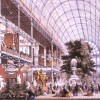Crystal Palace, Hyde Park
Designed by Joseph Paxton, the Crystal Palace was a cast-iron and plate-glass structure 564 meters long, with an interior height of 39 meters, and 92,000 square meters of exhibition space originally built in Hyde Park, London, to house the Great Exhibition of 1851. After the exhibition, the Palace was relocated to Penge Peak next to Sydenham Hill, South London, an affluent suburb of large villas. It stood there until its destruction by fire in 1936.
Parent Map
Coordinates
Latitude: 51.508535453470
Longitude: -0.165395736694
Longitude: -0.165395736694


